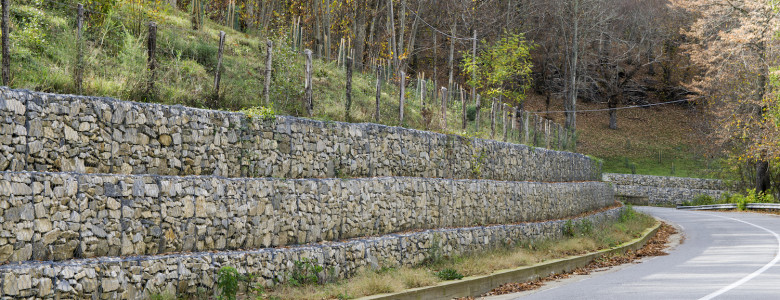Any retaining wall is only as good as the strength of its core. If your wall is upright and firm, then it will remain in place as needed. But if a wall has been poorly planned or installed, then it may not stay up for very long, and then what good is it? The keys to a successful retaining wall are a sturdy base, proper reinforcement, and sufficient drainage so water doesn’t seep in and disturb its stability. These are all vital to maintaining a sturdy retaining wall; if you think your wall lacks any of these factors, then you may need to improve the integrity of that wall. Here are some helpful tips to consider in determining the cause and origin of any potential problems.
The Purpose of Your Wall
Most retaining walls are made of two different types, a cantilever or gravity wall. Both are constructed primarily of concrete and/or concrete fortified materials. The first looks like an upside down “T” shape that uses a vertical stem and a horizontal foot to maintain stability, the other is built in a trapezoidal shape with a thick, wide base. Both are designed to hold and maintain large amounts of soil from collapsing forward. Each wall is built to withstand the force of the soil, which is constantly pushing against it.
Even a good retaining wall can fail and it doesn’t necessarily need to topple over to show signs of failure. In fact, it’s quite uncommon for a wall to actually fall or collapse. Instead, most of them will list to one side or display other visible structural deflections. The good news is that many walls can be fixed and the problems corrected before a wall comes tumbling down.
Check Your Reinforcements
Sometimes the reinforcements of your wall are at an improper depth. There are other issues like spacing and the size of the reinforcements that could prove to be the culprit in an unstable wall as well. Your wall may even have the reinforcing materials installed on the incorrect side. If the stem is displaying signs of deflection or cracking, you may have a reinforcing problem. Making sure all of the size, spacing, and depth specifications are up to standard will help you improve the integrity of a sagging wall.
Proper Drainage
No matter how well built your wall may be, the whole thing is doomed unless you have sufficient water drainage. If water is allowed to collect around or behind the wall and seep into the backfill, that can cause undue excess pressure. So making sure there is enough drainage capability to move that water away is essential. Think of it as a constant struggle between the wall and the backfill soil behind it. The two forces are at odds with each other, but you’ve built the wall in a way to stack the odds in its favor.
Water is the backfill material’s secret weapon in the fight. More water gives the material more strength and it can result in the wall losing the battle. You must stop that from happening by eliminating the water immediately.
Design and Detail Errors
These issues arise not from incompetent designers or contractors, but rather from faulty information that was used in the design of the retaining wall. People make mistakes and sometimes data isn’t accounted for correctly or conveyed thoroughly. The result is a retaining wall that is taking on more pressure than expected or built in an area lacking a secure foundation. These mistakes are often exacerbated when design software is used in the planning of the wall, as information can be entered incorrectly, thus throwing off all of the other facets of the design.
Common Solutions
Not all retaining walls are built the same and each has its own flaws when it comes to failing integrity. But there are some common fixes that can be performed on most walls that are showing signs of failure. Surface re-grading can make a big difference in cases where there is too much soil pressure against the wall or a lack of drainage to keep water from getting behind it.
Sometimes a wall can be secured through soil nailing which requires drilling through the wall and bolstering the structure into the soil behind it. It may even be as simple as using a different backfill material in cases of too much water saturation, choosing one instead that won’t absorb the water so easily.

